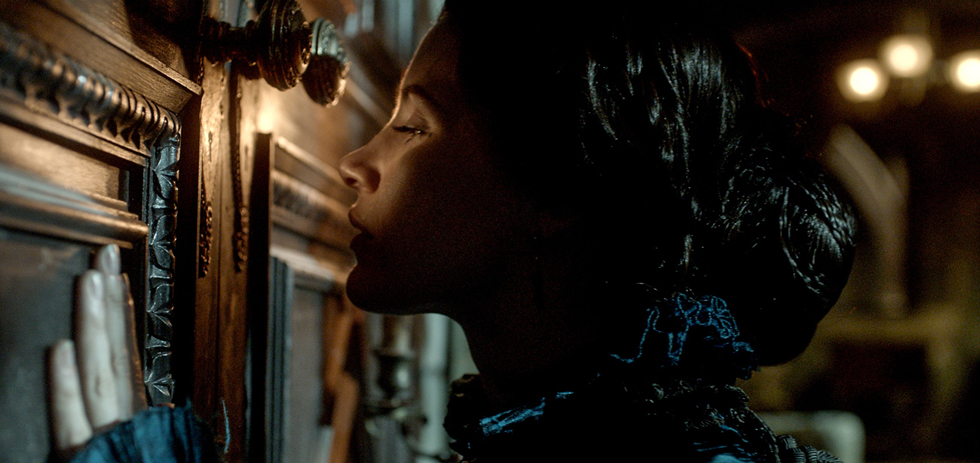Guillermo del Toro’s Crimson Peak is one of those weird and wonderful anomalies to come out of the studio system that is unable to be categorised into traditional genre labels we’ve come to associate with big budget, mainstream fare. Yes, it’s a horror movie in some sense – there are haunted houses, ghosts, loads of blood, murder, and mayhem – but to believe the film’s marketing and shoehorn it as such sells del Toro’s latest project short: Crimson Peak is a Giallo-infused gothic love story played totally straight.1 It owes as much to the visual palate of Dario Argento as it does to the novels of Charlotte Brontë, and owes virtually nothing (ignoring a handful of jump-scares) to any horror film to come out in the last few decades.2
Crimson Peak is the story of Edith Cushing (Mia Wasikowska – who turns in an amusing riff on her work in Madame Bovary and Jane Eyre), a young, aspiring author who despises marriage and the aristocracy.3 Since a young age, she has been haunted by images of her dead mother warning her of the titular “Crimson Peak”.4 She is also the daughter of Carter Cushing (Jim Beaver), a wealthy businessman with a strong moral backbone. Looking to raise revenue for a hair-brained, steam-punk scheme to extract crimson clay for application in brick manufacture for his property, Sir Thomas Sharpe (Tom Hiddleston) comes to America, seducing Edith (despite her best wishes). After the death of her father, and Thomas’s profession of undying love for her, Edith flees with her new husband to his estate in London, finding herself trapped in Allerdale Hall – an isolated, rundown manor – with Thomas’s sinister sister Lucille (Jessica Chastain – who appeared in the del Toro presented Mama). As it becomes apparent that not everything is as it seems, Edith – haunted by unknown apparitions – attempts to unravel the secrets hidden within her surroundings.
It should come as no surprise that Crimson Peak is not an ordinary horror film, given del Toro’s propensity to shoehorn external genre tropes into traditional forms (see: Pan’s Labyrinth‘s fairytale structure as an entrypoint to its anti-fascist narrative). In fact, his latest sits somewhere between Pan’s Labyrinth and the more conventional haunted-house spooker Don’t Be Afraid of the Dark, both in terms of its production and its costume design, with obvious reference to the Victorian period and its literature throughout thrown in for good measure.5 This referencing filters through near every facet of the film, even down to its repressed sense of sexuality, torn from the most entertainingly subpar descriptions of intimacy found in some of Brontë and Austen’s weakest erotic passages. All of the expected character archetypes are here too: the naiive but self-assured female lead, the lover with secrets and a dark past, his evil family members, the protective father, the man who lusts after the female lead who is sidelined – it’s a perfect combination of tropes that signal del Toro’s desire for the film to be assessed as a throwback tale of Gothic Romance. Dan Laustsen (of The Brotherhood of the Wolf fame) assists, weaving a rich cinematographic backing that is equal parts Giallo and Sense and Sensibility – del Toro is not interested in making your standard American 20th century horror piece.6

This is the sort of film that shouldn’t work as a whole, but does, managing to perfectly balance the healthy dose of homage, legitimate scares and goofiness in pulling off something so ridiculous and ambitious in concept. Much of the reason why Crimson Peak lands is because, whilst del Toro and co. diversify their references (never putting all their eggs into one genre basket), there is an assuredness in their execution that suggests such an approach isn’t just a scattershot attempt to satisfy as broad an audience as possible. Certain scenes perfectly mimic Argento’s use of colour, lighting, and water in some of Suspiria’s most abstract scenes, and there’s clear visual reference to Deep Red via an elevator in Allerdale Hall that comes a little bit too close for comfort to a few character’s scalps.
There are nods at haunted house benchmarks The Haunting and The Innocents, as well as a bathtub scene with obvious reference to Kubrick’s The Shining. Then there’s del Toro’s approach to the gothic romance novel, and costume-drama cinema in general, which guides the development of most of our plot structure and inserts itself formally in the use of iris wipes throughout the film’s first movement. In fact, in many senses it’s a film that works in volumes, rather than acts, allowing anyone with a familiarity of the basic gothic canon to pick the plot twists a mile away. It’s all part of the fun, though – a film that will reward viewers with knowledge of a greater filmic and literary canon, whilst not punishing those who lack it.
Structurally there are a few issues, the pacing lags in sections and occasionally tiresome sequences as characters struggle to unravel the simple and obvious mysteries that roadblock them. On the whole, though, Crimson Peak is a fun, refreshing jaunt through ridiculous territory that somehow manages to exude sincerity while avoiding total homage or self-satire. With a reasonable smattering of gore, and some absolutely breathtaking set and costume design, del Toro’s final product is a truly unique beast, one that deserves to be consumed on the big screen.

